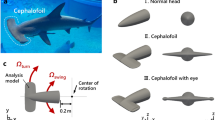Abstract
Pecten maximus (L.), when stimulated by contact with various sea-star species, displays several fairly distinct types of responses. These range from valve closure, through ‘jumping’ to the well-known swimming escape reaction. These responses are described in detail. The most violent responses are evoked by contact with the predatory sea starsAsterias rubens,Astropecten irregularis, andMarthasterias glacialis, whereas non-predatory sea stars may evoke minor reactions or none at all. It is suggested that, in this instance, the adaptive value of the various types of responses lies not only in enabling the scallop to escape from predators, but also in preventing needless and even hazardous movement away from the refuge of its prepared depression in the substratum when confronted by the less harmful species of sea stars. Crude chemical extracts of all sea stars always evoked escape reactions, but only those ofAsterias rubens andAstropecten irregularis caused the full swimming response.
Similar content being viewed by others
Literature cited
Ansell, A. D.: Leaping movements in the bivalvia. Proc. malac. Soc. Lond.38, 387–399 (1969).
Baird, R. H.: On the swimming behaviour of scallops (Pecten maximus L.). Proc. malac. Soc. Lond.33, 67–71 (1958).
— andF. A. Gibson: Underwater observations on escallop (Pecten maximus L.) beds. J. mar. biol. Ass. U.K.35, 555–562 (1956).
Buddenbrock, W. V. undI. Moller-Racke: Über den Lichtsinn vonPecten. Pubbl Staz. zool. Napoli24, 217–245 (1953.)
Bullock, T. H.: Predator recognition and escape response of some intertidal gastropods in presence of starfish. Behaviour5, 130–140 (1953).
Dakin, W. J.: The visceral ganglion ofPecten, with some notes on the physiology of the nervous system, and an enquiry into the innervation of the osphradium in the Lamellibranchiata. Mitt. zool. Stn Neapel20, 1–40 (1910).
Dickie, L. M. andJ. C. Medcof: Causes of mass mortalities of scallops (Placopecten magellanicus) in the southwestern Gulf of St. Lawrence. J. Fish. Res. Bd Can.20, 451–482 (1963).
Dodgson, R. W.: Report on mussel purification. Fishery Invest., Lond. (Ser. 2)10, 1–498 (1928).
Fänge, R.: Toxic factors in starfishes. Sarsia10, 19–21 (1963).
Feder, H. M.: Gastropod defensive responses and their effectiveness in reducing predation by starfishes. Ecology44, 505–512 (1963).
—: Organisms responsive to predatory sea stars. Sarsia29, 371–394 (1967).
— andM. Arvidsson: Studies on a sea star (Marthasterias glacialis) extract responsible for avoidance reactions in a gastropod (Buccinum undatum). Ark. Zool. (Ser. 2)19, 369–379 (1967).
— andM. Christensen: Aspects of asteroid biology.In: Physiology of Echinodermata, pp 87–129. Ed. byR. A. Boolootian. New York: Interscience Publishers 1966.
— andR. Lasker: Partial purification of a substance from starfish tube feet which elicits escape responses in gastropod molluscs. Life Sci.3, 1047–1051 (1964).
Galtsoff, P. S.: The American oysterCrassostrea virginica Gmelin. Fishery Bull. Fish. Wild. Serv. U.S.64, 1–480 (1964).
Gore, R. H.: Escape response onNassarius. Bull. mar. Sci.16 (3), 423–434 (1966).
Hoffman, H.: Über den Flucht Reflex beiNassa. Z. verg. Physiol.11, 662–688 (1930).
Kohn, A. J.: Chemoreception in gastropod molluscs. Am. Zool.1, 291–308 (1961).
Land, M. F.: Activity in the optic nerve ofPecten maximus in response to changes in light intensity and to patterm and movements in the optical environment. J. exp. Biol.45, 83–99 (1966).
Lecomte, J.: Reactions de finite des pectens en présence des astérides. Vie Milieu3, 57–60 (1952).
Mackie, A. M.: Avoidance reactions of marine invertebrates to either steroid glycosides of starfish or synthetic surface-active agents. J. exp. mar. Biol. Ecol.5 (1), 63–69 (1970).
— andP. T. Grant: Avoidance reactions of a molluscBuccinum undatum to saponin-like surface-active substances in extracts of the starfishAsterias rubens andMarthasterias glacialis. Comp. Biochem. Physiol.26, 415–428 (1968).
Margolin, A. S.: The mantle response ofDiodora aspera. Anim. Behav.12, 187–194 (1964a).
—: A running response ofAcmaea to sea stars. Ecology45, 191–193 (1964b).
Mortensen, T. H.: Handbook of the Echinoderms of the British Isles, 471 pp. London: Oxford University Press 1927.
Olsen, A. M.: Underwater studies on the Tasmanian commercial scallop,Notovola meridionalis (Tate). (Lamellibranchiata: Pectinidae). Aust. J. mar. Freshwat. Res.6, 392–410 (1955).
Owen, G.: Feeding.In: Physiology of Mollusca, Vol. 2, pp 1–51. Ed. byK. M. Wilbur andC. M. Yonge. New York: Academic Press 1966.
Thomas, G. E.: The responses ofPecten maximus L. to various starfish species, M.Sc. thesis, University of Wales 1969.
von Uexhull, J.: Die Pilgermuschel. Z. Biol.58, 305–332 (1912).
Yarnall, J. L.: The responses ofTegula furnebralis to starfish and predatory snails. Veliger6, 56–58 (1964).
Yasumoto, T., M. Tanaka andY. Hashimoto: Distribution of saponins in echinoderms. Bull. Jap. Soc. scient. Fish.32, 673–676 (1966).
Author information
Authors and Affiliations
Additional information
Communicated byJ. H. S. Blaxter, Oban
Rights and permissions
About this article
Cite this article
Thomas, G.E., Gruffydd, L.D. The types of escape reactions elicited in the scallopPecten maximus by selected sea-star species. Mar. Biol. 10, 87–93 (1971). https://doi.org/10.1007/BF02026771
Accepted:
Issue Date:
DOI: https://doi.org/10.1007/BF02026771



